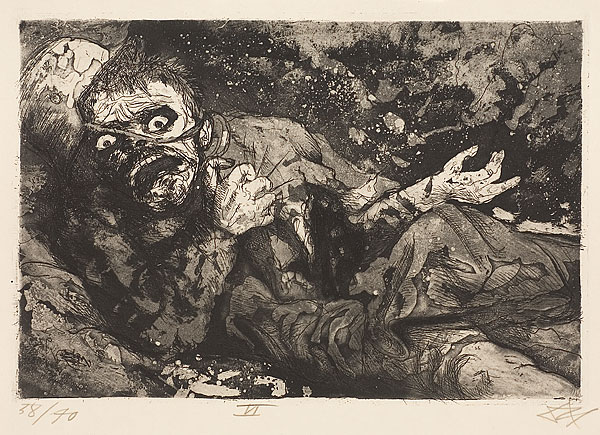Erica Weitzman’s article “Necessary Interruption: Traces of the Political in Levinas” draws a convincing comparison between Levinas’s ontological alterity ethics and the political theory of Carl Schmitt:
In the well-known interview with Schlomo Malka and Alain Finkielkraut on Radio Communauté given in response to the Sabra and Shatila massacres of 1982, Levinas is asked about the possibility of the Palestinian as the political “other” in relation to the Israeli, and the ethical and political consequences this might entail. Levinas’s altogether surprising and by now infamous response seems to dismiss entirely his own notion of infinite responsibility, and, instead, delivers an analysis that startlingly recalls the friend/enemy distinction of Carl Schmitt:
My definition of the other is completely different. The other is the neighbour, who is not necessarily kin, but who can be. And in that sense, if you’re for the other, you’re for the neighbour. But if your neighbour attacks another neighbour or treats him unjustly, what can you do? Then alterity takes on another character, in alterity we can find an enemy, or at least then we are faced with the problem of knowing who is right and who is wrong, who is just and who is unjust. There are people who are wrong.
How is one to reconcile this — if reconciliation is possible — with the infinite demand of the other, with Levinas’s idea of the self only brought to consciousness in the first place through its utter submission to and absolute responsibility for the other? For Levinas, evidently, some others are more due responsibility than other others. Levinas is not wrong in stating that Malka has fundamentally misinterpreted his philosophical writings. Indeed, his response makes clear that the other with whom the ethical relation is possible is subject to certain criteria. Or at least, these criteria come to emerge in the interruption of the ethical by the political.
Weitzman concludes that Levinas’s seeming contradiction here is not really a contradiction at all, but something that falls out of his ethics, which do not produce tolerance or pluralism, but in fact something much closer to Carl Schmitt’s polarized friend/enemy politics:
In this way, Levinas’s ethics of radical alterity in fact circle right back to the very sameness, totality, and totalitarianism which he himself finds so pernicious. The problem with Levinas’s ethics is not that it results in a passively suffering, masochistic, incapable subject, constantly at the mercy of the command of the other. The problem is that his ethics, in conceiving of alterity as something wholly beyond the borders of being and phenomenality, in fact cannibalizes alterity within the same. In this cannibalization of the other, the self takes on a psychotic hyperresponsibility that — in its transcendence and lack of necessity to correspond to any concrete situation or make any factical decision — becomes absolute irresponsibility, a sovereign will no longer even human but actually divine. “Justice,” according to this model, is a logical absurdity. For either the consensus Levinas’s thought seems to assume holds true — in which case there are no decisions or judgments to be made — or else the intrusion of the enemy puts all notions of justice and responsibility in suspension. Either there is no politics, the end of politics, utopia — or there is total war. The entrance of the third, which for Levinas is at once the necessary condition for the beginning of the political and the political a priori of the ethical relation itself, in fact only transforms the dyadic solipsism of the ethical relation into the plural solipsism of nationalism and fraternity.
Political theory is not my forte, so I will only comment on the philosophical side of things. When you have the sort of radical alterity that you find in Levinas, it really does become empty of content. Since the other is defined only in the sense of being wholly other, “alterity takes on another character” in wholly arbitrary ways. No criteria is possible besides that of total Otherness. It can be filled with the enemy just as easily as it can be filled with infinite ethical demand. Everything true becomes false. Black is white, friend is enemy, good is evil.
I think this is one of the points Hegel is making in the infamously obscure Inverted World section of the Phenomenology, which also seems to end in some kind of recognition of solipsism. If so, it’s a good point!
_____________
Note: for an indisputably indefensible Levinas passage, consider his comment on the Soviet-Chinese conflict in 1960, during which he adopted a pro-Soviet position:
The yellow peril! It is not racial, it is spiritual. It does not involve inferior values; it involves a radical strangeness, a stranger to the weight of its past, from where there does not filter any familiar voice or inflection, a lunar or Martian past.
Emmanuel Levinas, “The Russo-Chinese Debate and the Dialectic” (1960)
Zizek ties Levinas’s attitude here back to Heidegger.

![war30[1]](http://www.waggish.org/wp-content/uploads/2011/03/war301.jpg)

![Nocturnal_Encournter_with_a_Lunatic[1]](http://www.waggish.org/wp-content/uploads/2011/03/Nocturnal_Encournter_with_a_Lunatic1.jpg)


![Dix01[1]](http://www.waggish.org/wp-content/uploads/2011/03/Dix011.jpg)
![128611[1]](http://www.waggish.org/wp-content/uploads/2011/03/1286111.jpg)
![128600[1]](http://www.waggish.org/wp-content/uploads/2011/03/1286001.jpg)
![1925veil[1]](http://www.waggish.org/wp-content/uploads/2011/03/1925veil1.jpg)